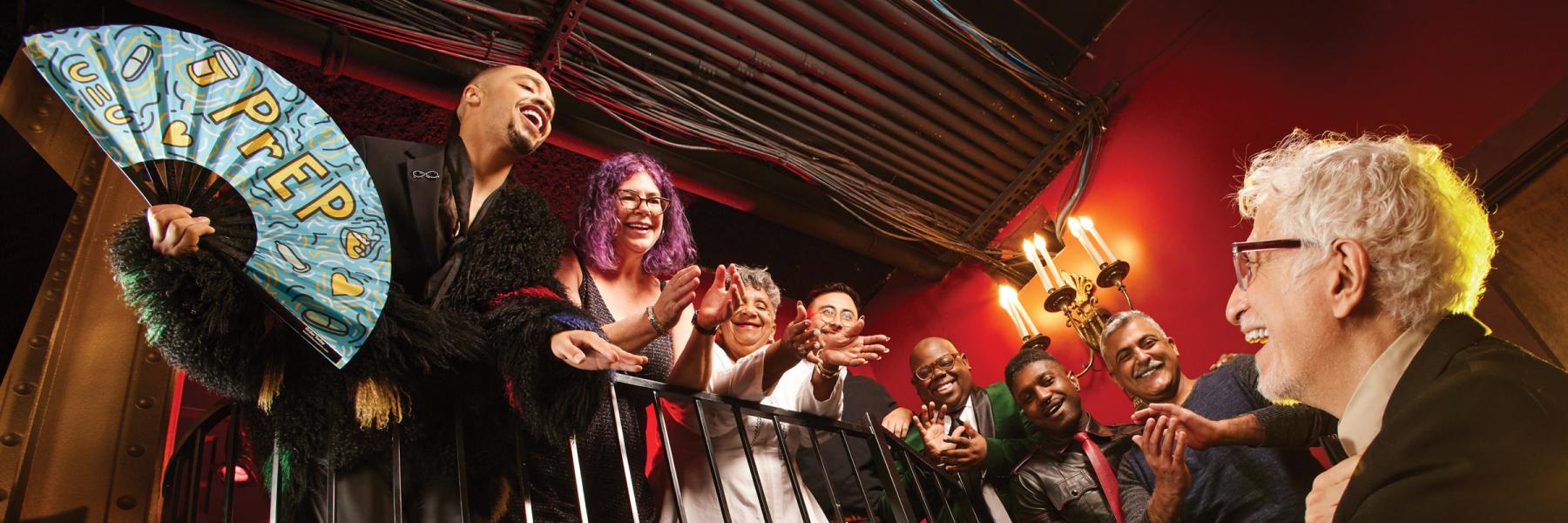
- Story by Rick Guasco
- Photography by John Gress
- Styling by William Martinez
For Aces Lira, 29, taking part in the cover photo shoot of the 27th annual Positively Aware HIV Drug Guide was the next milestone in his journey while finding connection with other people living with HIV.
“The timing felt right,” he said. “I knew doing this, I would connect with other people living openly about their experiences with HIV.”
Lira was excited at the opportunity to share his story and find community that he invited a couple friends to join him. While they weren’t ready as he was to go in front of the camera, they wanted to show their support, meeting him at The Baton Show Lounge, an iconic drag show venue in Chicago’s Uptown neighborhood, the location of the photo shoot.
“I myself was diagnosed two years ago,” said Lira’s friend Kyle. “I just came to show support and let him know that I was happy that he was confident enough to display in public that he's positive. I don't think I'm there yet in my journey to do that. Admiring and supporting him really is why I came.”
Another friend, Qiana, was also on hand. “I think it's pretty huge, what he's doing and I'm just very proud of him to be at this point in his journey,” she said.
“Even if the public doesn’t see them photographed, their love and support are still in the photos,” Lira said. “It helped having my friends physically present. While we waited for direction and set-ups, we would giggle together and meet with the others in the shoot. It's not often I get to meet and create friendships with other people living with HIV, and so I hold them in high regard. It meant everything to me having them there supporting me and enjoying themselves.”
For Lira, the photo shoot was a chance to socialize and even network. “The lightbulb went off for me during the shoot,” he said. “I realized we need moments to connect with one another more often. We might be living with HIV but we deserve to be humanized and be seen. We do what we can to create a support system, but the number of folks who are open about their status runs small. I wanted to introduce my friends to each other and this was an opportunity. They got to also meet other folks to exchange contact info and talk about projects they’re working on. I think at one point there was an informal support group sharing experiences with one another talking about changes to treatment over time and what brought us all here.”
A policy and advocacy manager for an HIV organization in Chicago, he reflected on his six years living with HIV. “It’s been a bittersweet experience,” he said. “On one end, my diagnosis created a window to meet incredibly inspiring people trying to make a difference for people vulnerable or living with HIV. On the other, it’s been years of breaking through feelings of shame and isolation when I was first diagnosed. I can still remember the few friends I reached out to when I first found out and the support and love they gave me helped anchor me. That’s reason enough for us to be open about our experiences and support one another when we need it.”
Judy Brown finds support groups have been a vital part of living with HIV. At 72, Brown has been living with HIV for 30 years.
“Support groups have been key to my staying strong; they are a safe space,” she said. “That’s why I love to help run and facilitate support groups. I've met a lot of amazing people who I probably would not know if I wasn't living with HIV. So, I look at it in that light. I've learned a lot from other people.”
Having a vision and a purpose are important to Brown. “I love advocacy work, especially to empower all women,” she said. “My vision was to live after my diagnosis in my forties. I think I've come a long way. I'm happy and proud.”
Nirmalpal Sachdev, 49, is proud of his 26 years living with HIV so far. “After receiving my diagnosis at 23 I thought my life was over,” he said. “Over the years, as medications improved, I have come to terms with my HIV status as a chronic illness that reminds me to take care of my health. Having to self-disclose to those I am intimate with about my status humbled me at such a young age. Having HIV reminded me that real good people are usually unafraid and accepting. I'm glad to have learned that lesson at such a young age.”
His desire to be a visible example of a long-term survivor motivated Sachdev to take part in the cover shoot. “I am living proof that having this virus inside me for over 25 years and taking a long, long, long list of various medications over the years hasn't changed my appearance or my desire to live,” he said. “I think it's important for those who are newly diagnosed, and those wondering what they will look like after years of medication, to see someone like me who’s had it for so long and still looks as sexy as ever. You just gotta keep going.”
For someone who is newly diagnosed, he offered this advice: “Take a deep breath. “Feel all the feels. Accept the range of emotions. Get angry if you need to, and then start looking for support. We are all here for you. You are not alone.”
Coleman “Boy Cole” Goode came to The Baton dressed to make more than just a fashion statement. “I believe that representation matters, we need to see ourselves reflected in positive imagery,” he said. “It's why I chose to be photographed in leather to represent all of those Leatherfolk who have come before and will come after me.”
The 42-year-old community organizer has been living with HIV for 17 years. “I live a life today where the only time I think about my HIV is when I take my meds,” he said. “HIV does not control my life because I'm more than someone living with HIV today.”
He added, “HIV is no longer a death sentence; medications have come a long way, and you will have a life beyond your wildest dreams.”
At about the same time Joel B. Cohen, 72, was diagnosed with HIV 27 years ago, he learned he had early-onset Parkinson’s disease (PD). An economist for 40 years, Cohen changed careers and became a social worker in 2019. He credits his rigorous exercise routine—and the demands of fatherhood—for his good health.
"I’m not trying to minimize the seriousness of HIV, but some things in my life need to yield to my need to prioritize demands in my life,” he said. “My T cell count was down to seven, but by the end of the first week following my diagnosis and hospitalization, I resumed taking solo care of my two school-age children. By the end of the fourth week following my diagnosis, I returned to work full-time. Stepping up my exercise routine —including sneaking in multiple sets of pushups during my days in the office—has not only slowed or halted the progression of PD, but has reversed it. About HIV, all I do is pop a pill once a day and continue following healthy habits—pretty simple in comparison to dealing with PD.”
Cohen pushed himself to do the photo shoot. “I have a tendency to isolate myself as I deal with issues surrounding my own health and my family,” he said. “I realize that others react pretty much the same as I do, and my participation contributes to the understanding, knowledge and feeling that none of us are alone or need to be alone. The strength offered by the HIV community benefits everyone.”
Appearing on the cover of the drug guide, Timothy S. Jackson has come full circle. “When I was newly diagnosed, I often flipped through the pages of Positively Aware, absolutely amazed at the bravery of people living with HIV sharing their story,” he said. “Seeing those advocates standing firmly in their truth unabashed by HIV-related stigma, it gave me the courage to do the same. My participation in the photo shoot will hopefully inspire someone newly diagnosed to take the same steps I did to beat back stigma.”
Jackson, 41, is the director of government relations for AIDS Foundation Chicago and has been living with HIV for 13 years. “As a Black gay man living with HIV, my life is deeply rooted in advocating on behalf of people living with HIV and amplifying the voices of the communities where my identities intersect.”
He shared what he would tell someone who is newly diagnosed. “First, I would tell them to breathe and that it will be okay. Secondly, I would tell them that they are loved and deserve to be loved. Finally, I would encourage them, if able, to find a network of people living with HIV to help cope with this new normal.”
Anyone can have HIV; Dani Kruse points to herself as an example. The owner of a catering and staffing company, she describes herself as “a white woman from Iowa.” Kruse had been “really sick for several years” with an inexplicable ailment. No one (including herself) had thought to test for HIV. She was diagnosed with AIDS in 2016. With only 10 T cells, doctors estimated she must have been living with untreated HIV for 12–20 years.
“I chose to be in this photo shoot because anyone can have HIV—including white, middle-aged women from small towns,” Kruse said. “I believe the only way to reduce the spread of this disease (virus really) is through education and ending stigma.”
She reflected on her life since diagnosis. “HIV changes your life, but does not change who you are. I was health conscious prior to my diagnosis, but I learned so much about the importance of sleep, the need for having a 'village’—I have some amazing friends in my village, including two pug puppies.
“I learned that I am an amazing kickass human being; you are, too,” she added. “Learn, become self-forgiving, give yourself a break. HIV is not as big as it might seem.”
D. Dontace Keyes, 33, has spent the last 15 years, “adapting to HIV,” as he described it. “I've just begun living. This is my life, and I don't give a damn about lost emotions. I've such a lot of love I've got to give; let me live.”
He was moved to join the photo shoot for the people in his life. “For my tribe of mothers, sistas and village of brothers who ever wondered, what will happen to all that beauty?” he said. “It’s living and giving.”


